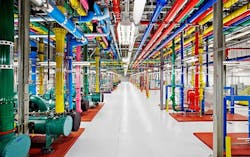Water scarcity in some parts of the U.S. has focused attention on data center development and the amount of water required to cool thousands of servers. How will the industry adapt to this challenge? That was a major point of discussion as the DCF Data Center Executive Roundtable explored the key themes in data center cooling for 2022 and beyond.
Our panelists include Heather Dooley of Infrastructure Masons, Data Aire’s Eric Jensen, Kevin Facinelli of Nortek Data Center Cooling, Aligned’s Tim Shaheen, Phillip Marangella of EdgeConneX, and Tim Mirick from Sabey Data Centers. The conversation is moderated by Rich Miller, the founder and editor of Data Center Frontier. Here’s today’s discussion:
Data Center Frontier: Cooling is a hot topic, as data center operators seek to balance growing use of AI hardware with commitments on sustainability and water use. What do you expect will be the key themes in data center cooling in the next several years?
TIM SHAHEEN, Aligned
Tim Shaheen, Aligned: Power density will continue to be critical metric when it comes to data center cooling due to customer requirements pushing the limits of legacy data center design. How densification translates to lower TCO, minimized CapEx investment, better efficiencies and lower PUE versus adding more data center space will be a critical talking point as well, especially as securing land for expansion continues to become a challenge in legacy Tier 1 markets and regions. A standardized cooling system that can handle rising densities and enable customers to scale in place without needing to move to exotic cooling solutions proves critical as sophisticated customers require more.
Water scarcity and data center sustainability will also continue to be key themes in the next several years. Collectively, data centers are among the top-ten water consuming industrial or commercial industries in the U.S. One-fifth of legacy data center servers’ direct water footprint comes from moderately to highly water-stressed watersheds, while nearly half of servers are fully or partially powered by power plants located within water-stressed regions.
In order to support the density demands brought about by next-generation tech, data center infrastructure and cooling systems must become more adaptive, efficient, and environmentally responsible—and that extends to cooling systems with the flexibility to go waterless or connect to water-cooled systems, as necessary—in an increasingly water-stressed world.
KEVIN FACINELLI, Nortek Data Center Cooling
Kevin Facinelli, Nortek: One thing that’s predictable is AI computing will generate more rack power density. That’s why data centers should future-proof their facilities now with cooling plant strategies that are scalable. For example, if more servers are added to a data hall, liquid cooling at the rack can easily be integrated to cool the added heat load. Future-proofing a facility with cooling equipment alternatives, such as modular equipment with small footprints that can be easily integrated to existing equipment, should be part of all data centers’ long-term goals.
Future heat loads can be accommodated with as many modular cooling plants and coil walls that space allows. Sustainability and TCO are more critical now than ever before. A good example is India-based colocation operator RackBank, which is building a 180MW GigaCampus platform project. Their goal is a 100-percent clean energy facility with zero carbon footprints. To accomplish this they’re using some of the most sustainable liquid cooling equipment in the industry. Water is a limited resource in India, so RackBank’s cooling equipment uses up to 90-percent less water than the traditional liquid cooling methodology. RackBank’s admirable efforts will make a difference in India’s resources, especially when similar sustainability is applied to its 500MW pan-India expansion in several cities.
We see this type of sustainability and efficient water use as the future of the data center industry for hyperscale and colocation facilities for maintaining low TCO.
ERIC JENSEN, Data Aire
Eric Jensen, Data Aire: Nowadays water use is often isolated from other components of sustainability, and rightly so, because for too long is was missing from the conversation. For the practices to continue to improve, the dialogue needs to become more comprehensive rather than more focused. Designs are taking a more holistic and deeper approach to sustainability evaluations, and considering the embodied energy in the water and the embodied water in the power.
Sometimes, counterintuitively, the power generation for a site may consume more water than the site would consume for equivalent power savings achieved through an open-loop system. To dismiss this as taboo is to dismiss the fact-based engineering. Hybrid solutions, combining highly efficient and scalable DX systems with waterside (closed or open loop) or airside economization, can achieve unparalleled efficiency in a redundant and resilient setup -without the dangers posed by an all-in/all-or-nothing approach.
RICK CRUTCHLEY of Iron Mountain.
Rick Crutchley, Iron Mountain: When we talk about cooling, it all comes down to efficiency. There’s a great opportunity to improve performance of existing sites, as well as new data centers. The trend will be to accept higher electrical use in exchange for less water use. The tools and the solutions are improving. That includes AI and controls that integrate weather data, for instance.
In addition, you’ve got desktop analytics and tools to optimize the data halls, layouts and airflow. There are now engineering models that can identify optimal upgrades, so you have an efficient implementation and the best implementation for your dollar. You’ll see water treatment systems to minimize and conserve water.
There is also the opportunity to retrofit or upgrade aging data centers. We’re seeing some interesting partners that are looking at ways to help providers improve their aging sites and are offering financial paybacks for making upgrades and improvements.
Density is growing alongside compute demand, and AI is an excellent example of a technology driving such deployments. Companies in cutting-edge spaces like AI will innovate at a blistering rate, and their operators will need to collaborate closely with them to stay ahead of their future requirements.
As a long-term partner in this space, we have found that a flexible design is a key to providing long-term peace of mind and confidence to our customers. We begin with air cooling that supports up to 100kW racks but retains the capability to pivot to liquid or even immersion cooling when the hardware demands and supports it.
HEATHER DOOLEY, Infrastructure Masons and HDCManagement.
Heather Dooley, Infrastructure Masons: Power, water and materials efficiency and sustainability will be among the key themes in data center cooling. I expect more innovation and R/D spend to solve resource constraints across data center operators.
I also expect to see more community engagement at local levels, increasing data center operator responsibility to be transparent on use and long-term sustainability goals. Scarcity can lead to self-interest.
A more ideal outcome is that the industry finds better ways to partner on the best ideas that lead to innovative solutions.
TIM MIRICK, Sabey Data Centers
Tim Mirick: Density is growing alongside compute demand, and AI is an excellent example of a technology driving such deployments. Companies in cutting-edge spaces like AI will innovate at a blistering rate, and their operators will need to collaborate closely with them to stay ahead of their future requirements.
As a long-term partner in this space, we have found that a flexible design is a key to providing long-term peace of mind and confidence to our customers. We begin with air cooling that supports up to 100kW racks but retains the capability to pivot to liquid or even immersion cooling when the hardware demands and supports it.
PHILLIP MARANGELLA, EdgeConneX
Phillip Marangella, EdgeConneX: Sustainability is becoming stable table stakes for every provider and a mantra for the data center industry as a whole. More than just carbon or water, it’s thinking about sustainability holistically.
We are all sourcing and implementing technologies and solutions that are environmentally sustainable. We are also collaborating and sharing best practices, which is exciting to see.
NEXT: What might metaverse technologies mean to demand for data center space?
Keep pace with the fact-moving world of data centers and cloud computing by following us on Twitter and Facebook, connecting with DCF on LinkedIn, and signing up for our weekly newspaper using the form below:







